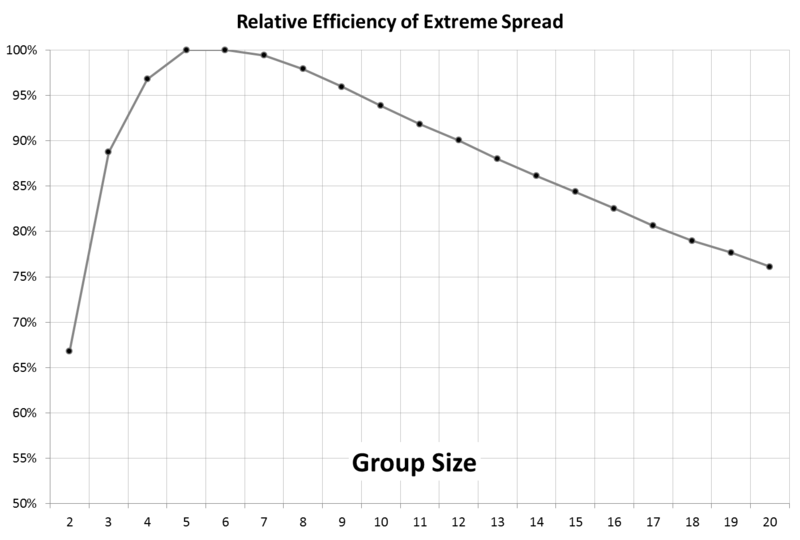You are using an out of date browser. It may not display this or other websites correctly.
You should upgrade or use an alternative browser.
You should upgrade or use an alternative browser.
How much "Extreme Spread" is acceptable in competition?
- Thread starter Mulligan
- Start date
Will the 4th and 5th roll of 3 pairs of dice always be 36?
dmoran
Donovan Moran
Maybe your accuracy levels, reloading practices, and test control aspects are comparable as the odds of rolling a pair of 6-sided square dice.Will the 4th and 5th roll of 3 pairs of dice always be 36?
If you ever get to a state where your scenario's are more comparable to rolling balls at a hole, you'll be more inline with reality.
Very poor comparison --- but do keep thinking !.!.!
That's not the standard statistical "bell" curve used to show statistical shot distribution from group center in one or more axes.
It's one used by Playtex and Victoria's Secret designing bras for women. It's called a "boob" curve. That one is for women laying down.
Someone sure snookered you.
dmoran
Donovan Moran

That's not the standard statistical "bell" curve used to show statistical shot distribution from group center in one or more axes.
It's one used by Playtex and Victoria's Secret designing bras for women. It's called a "boob" curve. That one is for women laying down.
-----------------------------------------------------------------------------------------------
Last edited:
I just love all the passion and creativity in these posts! ...lol
Alex Wheeler
Site $$ Sponsor
I'll throw out a few facts, I dont know many of them but...
ES is not directly tied to group size
In Benchrest we shoot groups
If your ES is holding your groups back fix it
If its not fix something else
If your under 20 ES thats not your problem...
ES is not directly tied to group size
In Benchrest we shoot groups
If your ES is holding your groups back fix it
If its not fix something else
If your under 20 ES thats not your problem...
Alex, can you polish on this some?I'll throw out a few facts, I dont know many of them but...
ES is not directly tied to group size
In Benchrest we shoot groups
If your ES is holding your groups back fix it
If its not fix something else
If your under 20 ES thats not your problem...
Ben
Apparently, you Sir, cannot grasp and/or accept that there are proven verifiable tests & ballistic programs that, without a shadow of a doubt, account for those very "confounding factors" I've mentioned...from the get go...
So, you're more than welcome to try shifting the narrative away from scientific fact, since as of yet, not a single solitary one of you gents can explain away how ANY reloader/ tester can subjectively choose to heed, or ignore tangible data, at ones own discretion?
This may be well & good in your own minds, for whatever justification you can cook up. 'Attacking the messenger' is the most elementary way to do so, especially when the actual facts of the matter cannot be refuted...
So, let's get back to the ballistic discussion, shall we?
Please explain why such a widely accepted & utilized program as Quickload includes a user input for "maximum case capacity"?
Who over @ Quickload camp nominated themselves "arbitrator" for that dispensation of erroneous data point???
The nerve of 'em!
Those gents should know that case capacity only matters when (input your name here) has decided it's convenient! To heck with all that science jumbo jumbo....
And, (again) why did those USAF scientists specifically structure their primer test to negate "confounding factors" from skewing the data they sought to collect on specific primers?
Here's yet another opportunity to explain your stance on THOSE facts.
Or, you could think hard about how you can spin this back onto me (the messenger), since the message of truth is too tough to swallow...
Tell ya one thing, if I'm ever proven WRONG, I will be the first to step up and admit it. So, please...take all the time you need to do just that!
Prove to me that variable case capacity has absolutely ZERO EFFECT on pressure, velocity & downrange POI shift. I've got the science to prove that it does, and conventional reloading practices agree, as well. If you care to debate that fact, here's NECOS Quickload email contact:
sales@neconos.com
I'm sure they'd love to learn from you, how their program is missing an "ignore case capacity" button next to the data field!
To direct right back to main point:
For our discussion, there are three main things affect pressure generated in a vessel:
1. Volume of the vessel
2. Volume of propellant
3. 'Energy' added by the primer to inpgnite the propellant
So, if one seeks to test the variation of any one of those three main factors, one must keep the other two, as a constant. If that very simple, very obvious methodology is not adhered to, the test results are flawed.
How can it be, any other way?
Reading your recent thread on statistics I immediately thought of this 10 page thread and how the positive, encouraging comments helped amidst the comments from the "that'll never work crowd". Your post, the one I quoted above, made me laugh. That post actually prompted me to post the results anyway knowing I would likely get a ton of bull squirt over the the process, and procedures I used, and of course, the results and what I gleaned from them.Easy test. Color and shoot them at 1k. Share your results if you like to hear that you dont have enough scientific data or that you cant see a difference at 100 in a ppc!
Thanks for that.
CW
Similar threads
- Replies
- 13
- Views
- 762
Upgrades & Donations
This Forum's expenses are primarily paid by member contributions. You can upgrade your Forum membership in seconds. Gold and Silver members get unlimited FREE classifieds for one year. Gold members can upload custom avatars.

Click Upgrade Membership Button ABOVE to get Gold or Silver Status.
You can also donate any amount, large or small, with the button below. Include your Forum Name in the PayPal Notes field.
To DONATE by CHECK, or make a recurring donation, CLICK HERE to learn how.

Click Upgrade Membership Button ABOVE to get Gold or Silver Status.
You can also donate any amount, large or small, with the button below. Include your Forum Name in the PayPal Notes field.
To DONATE by CHECK, or make a recurring donation, CLICK HERE to learn how.










